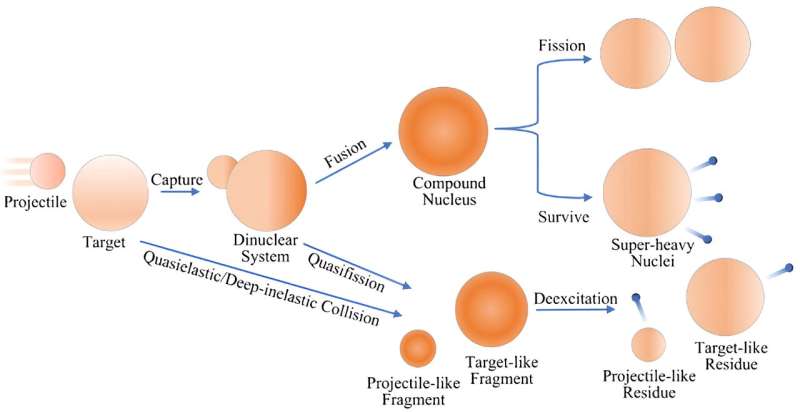
September 30, 2024 by Nuclear Science and Techniques
Collected at: https://phys.org/news/2024-09-insights-exotic-nuclei-creation-langevin.html
Researchers have introduced a model based on the Langevin equation that offers new insights into the formation of exotic nuclei. This development could enhance the ability to produce rare isotopes that are valuable for various applications in science and medicine.
The study is published in the journal Nuclear Science and Techniques.
A research team led by Professor Feng-Shou Zhang has developed and applied this model to study multinucleon transfer (MNT) processes in heavy-ion collisions. The model provides a more precise understanding of energy dissipation during heavy-ion collisions, which is important for predicting nuclear reaction outcomes. Simulations of nuclear reactions, such as 40Ar + 232Th, 136Xe + 238U, and 136Xe + 209Bi, have shown that the model’s predictions of cross-sections and angular distributions are in good agreement with experimental results.
Modeling nuclear reactions, particularly those involved in producing exotic nuclei, is challenging due to their complexity. Conventional methods like projectile fragmentation and fusion-evaporation have limitations, particularly in synthesizing new transuranium and superheavy elements.
This model addresses these challenges by simplifying the process, reducing the number of adjustable parameters, and focusing on key physical processes. It successfully simulates energy and scattering angle distributions, offering insights into deep inelastic and quasi-fission processes.
 Center-of-mass angular distribution of the damped cross section for events with TKE within the indicated range in the 136Xe + 209Bi reaction at Elab = 1130 MeV. Histogram is the calculation. Credit: Ying Zou
Center-of-mass angular distribution of the damped cross section for events with TKE within the indicated range in the 136Xe + 209Bi reaction at Elab = 1130 MeV. Histogram is the calculation. Credit: Ying Zou A simulated trajectory for the 40Ar + 232Th collision at Elab = 388 MeV. The trajectory and its projections of the evolution of total kinetic energy (TKE), elongation, and mass of heavier nucleus are illustrated. For each impact parameter, 500 trajectories have been simulated. Credit: Ying Zou
A simulated trajectory for the 40Ar + 232Th collision at Elab = 388 MeV. The trajectory and its projections of the evolution of total kinetic energy (TKE), elongation, and mass of heavier nucleus are illustrated. For each impact parameter, 500 trajectories have been simulated. Credit: Ying Zou
The improved accuracy of MNT reaction predictions provided by this model could facilitate the production of isotopes that are difficult to generate using other methods. These isotopes are valuable for scientific research and medical applications, such as diagnostics and treatments. According to Prof. Zhang, the goal is to keep the model comprehensive yet practical for experimental use.
This development represents a step forward in nuclear physics, contributing to the understanding of exotic nuclei production through MNT reactions. Further refinement of the model may enhance its utility in guiding future research and improving rare isotope production processes.
This research was conducted in collaboration with Beijing Normal University, Beijing Academy of Science and Technology, and the National Laboratory of Heavy Ion Accelerator of Lanzhou.
More information: Ying Zou et al, Investigation of multinucleon transfer processes in the Langevin equation model, Nuclear Science and Techniques (2024). DOI: 10.1007/s41365-024-01557-4

Leave a Reply